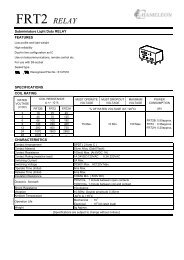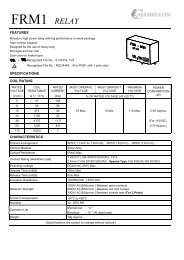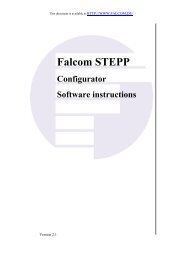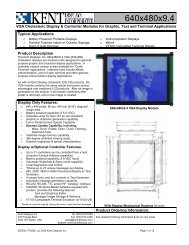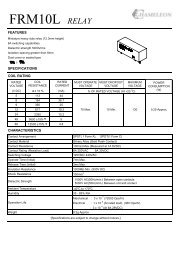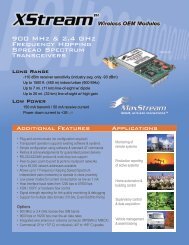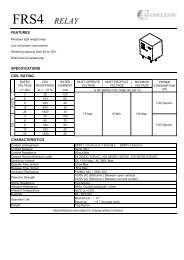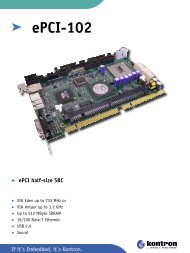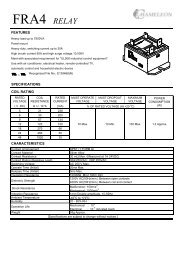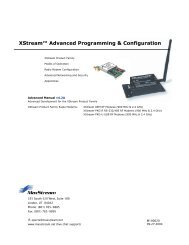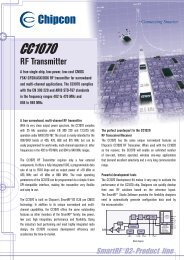STANDARD SERIAL COMMUNICATION INTERFACE and ...
STANDARD SERIAL COMMUNICATION INTERFACE and ...
STANDARD SERIAL COMMUNICATION INTERFACE and ...
You also want an ePaper? Increase the reach of your titles
YUMPU automatically turns print PDFs into web optimized ePapers that Google loves.
St<strong>and</strong>ard Serial Interface Protocol Description<br />
As indicated previously, the 10120, 1/8 VGA controller module will load display image data into memory<br />
sequentially, into the next available memory location. Since the controller has a finite amount of memory<br />
storage capacity, the interface software (“1/8VGASoft”, or equivalent) will need to either keep track of the<br />
amount of bytes used in the respective controller address prior to transmitting, or the controller will need<br />
to be “asked” the amount of available memory for an additional display message storage. For instance,<br />
the maximum amount of message data that can be loaded into a 1/8 VGA controller can not exceed<br />
43,817 bytes.<br />
The following items pertain to maximizing the number of complete messages stored by a 1/8 VGA, 10120<br />
controller module:<br />
o To maximize the number complete messages to be loaded into a controller module, use textbased<br />
messages (full, partial, flashing or partial screen text dynamic update) whenever possible.<br />
For instance, the 1/8 VGA controller can store only 9 complete full screen graphic messages<br />
{4814 [bytes/message] x 9 [messages] = 43,326 [bytes]}, whereas the same controller can store<br />
52 complete full screen text based message {833 [bytes/message] x 52 [messages] = 43,316<br />
[bytes]}, which is less than the 43,817 bytes capacity. Additional message storage capacity can<br />
be obtained if partial screen text images are used whenever possible.<br />
5.4.3.1 Controlling <strong>and</strong> Determining the Message Count (10120 Controller Only)<br />
The following application comm<strong>and</strong>s are available to the user to enable the interface to query (or “ask”)<br />
the 1/8 VGA controller the amount of available RAM memory left for additional message storage, <strong>and</strong> to<br />
enable the user to clear existing memory in the event the controller dynamic message storage algorithm<br />
becomes fragmented.<br />
# (Field #4) (Field #5) (Field #6)<br />
# Cmd. Content<br />
Byte Typical Byte Message Description<br />
Designation<br />
Count Content Count<br />
1 "M" N/A 0 N/A 0 Output "M"essage storage availability from<br />
controller. Host will receive message f/controller<br />
after positive response is received.<br />
2 “>”<br />
(3e in Hex)<br />
N/A 0 N/A 0 Clear All Previously Received Message Data<br />
(overides any previous Message trigger or<br />
Automatic cycle comm<strong>and</strong> received).<br />
Table 5.4.4: Additional Controller Memory Allocation/Query Comm<strong>and</strong>s<br />
As indicated from the table above, the interface will receive a message like the following example after<br />
the 320x80 controller receives a “M” comm<strong>and</strong>:<br />
RAM Bytes Used = 0791<br />
RAM Bytes Available = A398<br />
RAM Fragmented = 0000<br />
The quantities provided on each line after the introductory text is output in ASCCI hexadecimal format.<br />
As illustrated in the example above, the given 1/8 VGA controller currently has 0791 (1937 10 ) bytes<br />
occupied with user message data, has A398 (41,880 10 ) bytes available for additional message storage,<br />
<strong>and</strong> has 0 bytes wasted due to fragmentation of the message data.<br />
On current 1/8 VGA controller designs, message data fragmentation will only occur if the user changes an<br />
existing message (for a given message <strong>and</strong> display number) from one message type, to another as<br />
indicated in table 5.4.3. If the amount of RAM space, which is fragmented, becomes excessive, the user<br />
(or the “interface”) may wish to output a “Clear All Previously Received Message Data” comm<strong>and</strong> (“>”<br />
St<strong>and</strong>ard Serial Communication Interface Description, © 1998-2002 Kent Displays Inc., doc. # 25016 Revision T, Page 26 of 52



